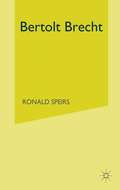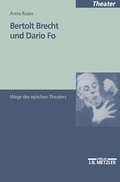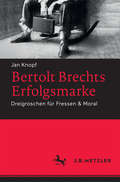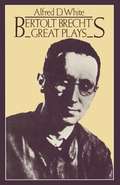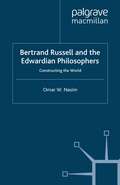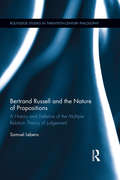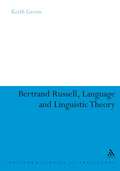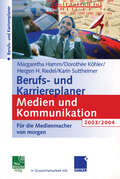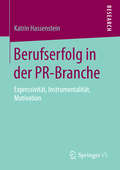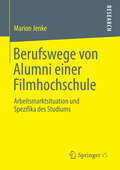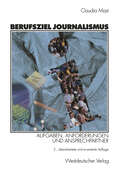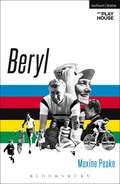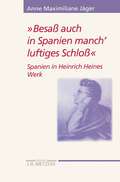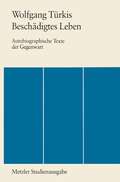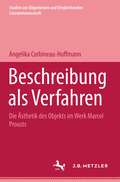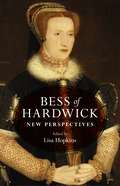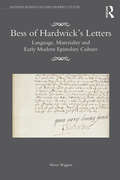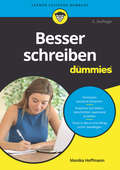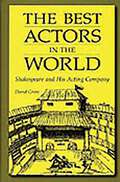- Table View
- List View
Bertolt Brecht (Modern Dramatists)
by Ronald SpeirsBrecht's reputation, which is now world-wide, rests principally on his contribution to political theatre in the twentieth century. He is known, not only for such major plays as Mother Courage and her Children, The Life of Galileo, The Good Person of Szechwan, or The Caucasian Chalk Circle, and for the concepts of 'Epic Theatre' or the 'alienation effect', but also for the exemplary productions with which the Berliner Ensemble scored successes both at its home in East Berlin and on its influential tours throughout Europe. However, Brecht also produced important work in the 1920s, before he became a committed political dramatist. This study therefore surveys his whole development, considering both the continuities and the discontinuities between his earlier and his later, Marxist, work examining critically the relations between theory and practice, and studying the major plays in detail. It argues that Brecht's procedures both of writing and production are better understood as rhetorical strategies than as 'scientific' demonstrations. '...Dr Speirs provides a balanced amount of description and of analysis, which together with details of productions (supported by eight pages of illustrations) will stimulate students of Brecht's drama as literature, as well as those interested in performance. A valuable addition to any school or college library, it is also at its very reasonable paperback price, a book which all Brecht enthusiasts will be able to purchase.' Times Educational Supplement.
Bertolt Brecht und Dario Fo: Wege des epischen Theaters
by Anna RussoIn einem programmatischen Dokument hat Dario Fo die epische Dramatik Bertolt Brechts für die Praxis seines politischen Theaters als die geeignetste erklärt. So bedient er sich der Brechtschen Verfremdungsmethoden, aber auch der traditionellen Formen des Volkstheaters, von der Farce und der Commedia dell´arte über die Pantomime bis zum Puppen- und Marionettenspiel. Während jedoch Brecht die Bühne in einen Ort der Reflexion verwandeln will, ist für Fo das Theater ein politisches Kampfmittel. Ende der sechziger Jahre betritt der Theatermann den Boden des Happenings und der direkten Aktion und stellt sich in den Dienst der Massenbewegungen der italienischen Linken. Damit verändert sich auch die Bindung des Theaters an die Wirklichkeit: Theater wird zur Lebensform.
Bertolt Brechts Erfolgsmarke: Dreigroschen für Fressen & Moral
by Jan KnopfDas Buch vor dem Film. – Am 31. August 1928 schlug Brechts Dreigroschenoper im Berliner Theater am Schiffbauerdamm wie eine Bombe ein und beendete die Herrschaft der hohen Kultur in Deutschland. Doch Brechts größter Erfolg ging bald in der Unterhaltungsindustrie auf: der Haifisch verlor seine Zähne. 1930 entwarf Brecht einen Dreigroschenfilm, nannte ihn Die Beule und versuchte dem Dreigroschenstoff mit den avantgardistischen Film-Techniken der Zeit seinen gesellschaftskritischen Biss wiederzugeben. Den möglichen Film verhinderten die Apparate der schwergewichtigen Filmproduzenten sowie die Politik. – Jan Knopfs Buch erzählt die dornenreiche wie ruhmgekrönte Story, die zu Brechts Erfolgsmarke führte, und bezieht dabei unbekannte Dokumente wie die Urfassung des Schlüsselstücks der Weimarer Republik, Mann ist Mann, ein. Darüber hinaus legt Knopf ein Treatment für einen Dreigroschenfilm vor, den Brecht womöglich im digitalen Zeitalter gern realisiert hätte.
Bertrand Russell and the Edwardian Philosophers: Constructing the World (History of Analytic Philosophy)
by O. NasimThe author demonstrates the significant role that some of the Edwardian philosophers played in the formation of Russell's work on the problem of the external world done at the tail-end of a controversy which raged between about 1900-1915.
Bertrand Russell and the Nature of Propositions: A History and Defence of the Multiple Relation Theory of Judgement (Routledge Studies in Twentieth-Century Philosophy)
by Samuel LebensBertrand Russell and the Nature of Propositions offers the first book-length defence of the Multiple Relation Theory of Judgement (MRTJ). Although the theory was much maligned by Wittgenstein and ultimately rejected by Russell himself, Lebens shows that it provides a rich and insightful way to understand the nature of propositional content. In Part I, Lebens charts the trajectory of Russell’s thought before he adopted the MRTJ. Part II reviews the historical story of the theory: What led Russell to deny the existence of propositions altogether? Why did the theory keep evolving throughout its short life? What role did G. F. Stout play in the evolution of the theory? What was Wittgenstein’s concern with the theory, and, if we can’t know what his concern was exactly, then what are the best contending hypotheses? And why did Russell give the theory up? In Part III, Lebens makes the case that Russell’s concerns with the theory weren’t worth its rejection. Moreover, he argues that the MRTJ does most of what we could want from an account of propositions at little philosophical cost. This book bridges the history of early analytic philosophy with work in contemporary philosophy of language. It advances a bold reading of the theory of descriptions and offers a new understanding of the role of Stout and the representation concern in the evolution of the MRTJ. It also makes a decisive contribution to philosophy of language by demonstrating the viability of a no-proposition theory of propositions.
Bertrand Russell and the Nature of Propositions: A History and Defence of the Multiple Relation Theory of Judgement (Routledge Studies in Twentieth-Century Philosophy)
by Samuel LebensBertrand Russell and the Nature of Propositions offers the first book-length defence of the Multiple Relation Theory of Judgement (MRTJ). Although the theory was much maligned by Wittgenstein and ultimately rejected by Russell himself, Lebens shows that it provides a rich and insightful way to understand the nature of propositional content. In Part I, Lebens charts the trajectory of Russell’s thought before he adopted the MRTJ. Part II reviews the historical story of the theory: What led Russell to deny the existence of propositions altogether? Why did the theory keep evolving throughout its short life? What role did G. F. Stout play in the evolution of the theory? What was Wittgenstein’s concern with the theory, and, if we can’t know what his concern was exactly, then what are the best contending hypotheses? And why did Russell give the theory up? In Part III, Lebens makes the case that Russell’s concerns with the theory weren’t worth its rejection. Moreover, he argues that the MRTJ does most of what we could want from an account of propositions at little philosophical cost. This book bridges the history of early analytic philosophy with work in contemporary philosophy of language. It advances a bold reading of the theory of descriptions and offers a new understanding of the role of Stout and the representation concern in the evolution of the MRTJ. It also makes a decisive contribution to philosophy of language by demonstrating the viability of a no-proposition theory of propositions.
Bertrand Russell, Language and Linguistic Theory (Continuum Studies in British Philosophy)
by Keith GreenAlthough there has been a significant revival in interest in Bertrand Russell's work in recent years, most professional philosophers would still argue that Russell was not interested in language. Here, in the first full-length study of Russell's work on language throughout his long career, Keith Green shows that this is in fact not the case. In examining Russell's work, particularly from 1900 to 1950, Green exposes a repeated emphasis on, and turn to, linguistic considerations. Green considers how 'linguistics' and 'philosophy' were struggling in the twentieth century to define themselves and to create appropriate contemporary disciplines. They had much in common during certain periods, yet seemed to continue in almost total ignorance of one another. This negative relation has been noted in the past by Roy Harris, whose work provides some of the inspiration for the present book. Taking those two aspects, Green's aim here is to provide the first full-length consideration of Russell's varied work in language, and to read it in the context of developing contemporary (i.e. with Russell's work) linguistic theory.The main aims of this important new book, in  focusing exclusively on Russell's work on language throughout his career, are to place Russell within the changing contexts of contemporary linguistic thought; to read Russell's language-theories against the grain of his own linguistic practice; to assess the relationship between linguistic and philosophical thought during Russell's career, and to reassess his place in the history of linguistic thought in the twentieth century. As such, this fascinating study will make a vital contribution to Russell studies and to the study of the relationship between philosophy and linguistics.
Bertrand Russell, Language and Linguistic Theory (Continuum Studies in British Philosophy)
by Keith GreenAlthough there has been a significant revival in interest in Bertrand Russell's work in recent years, most professional philosophers would still argue that Russell was not interested in language. Here, in the first full-length study of Russell's work on language throughout his long career, Keith Green shows that this is in fact not the case. In examining Russell's work, particularly from 1900 to 1950, Green exposes a repeated emphasis on, and turn to, linguistic considerations. Green considers how 'linguistics' and 'philosophy' were struggling in the twentieth century to define themselves and to create appropriate contemporary disciplines. They had much in common during certain periods, yet seemed to continue in almost total ignorance of one another. This negative relation has been noted in the past by Roy Harris, whose work provides some of the inspiration for the present book. Taking those two aspects, Green's aim here is to provide the first full-length consideration of Russell's varied work in language, and to read it in the context of developing contemporary (i.e. with Russell's work) linguistic theory.The main aims of this important new book, in focusing exclusively on Russell's work on language throughout his career, are to place Russell within the changing contexts of contemporary linguistic thought; to read Russell's language-theories against the grain of his own linguistic practice; to assess the relationship between linguistic and philosophical thought during Russell's career, and to reassess his place in the history of linguistic thought in the twentieth century. As such, this fascinating study will make a vital contribution to Russell studies and to the study of the relationship between philosophy and linguistics.
Berufs- und Karriereplaner Medien und Kommunikation 2003/2004: Für die Medienmacher von morgen
by Margaretha Hamm Dorothee Köhler Hergen Riedel Karin SuttheimerDer "Berufs- und Karriereplaner Medien und Kommunikation" beantwortet die meisten Fragen rund um den richtigen Berufseinstieg in die Medien- und Kommunikationsbranche.
Berufserfolg in der PR-Branche: Expressivität, Instrumentalität, Motivation
by Katrin HassensteinKatrin Hassenstein stellt die nach gängiger These den Frauen zugesprochenen besseren kommunikativen, empathischen und sozialen Fähigkeiten, die im feminisierten Berufsfeld Public Relations (PR) angeblich zu einem beruflichen Vorteil führen sollen, in den Fokus. Unter welchen konkreten Bedingungen machen Frauen und Männer im Berufsfeld Public Relations Karriere? Befragt wurden Pressesprecherinnen und Pressesprecher in Deutschland. Damit liefert die Autorin Erkenntnisse zum Zusammenhang zwischen geschlechtsspezifischen Persönlichkeitseigenschaften, der beruflichen Motivation und dem Berufserfolg weiblicher und männlicher PR-Praktiker.
Berufswege von Alumni einer Filmhochschule: Arbeitsmarktsituation und Spezifika des Studiums
by Marion JenkeDie Hochschule für Film und Fernsehen „Konrad Wolf“ ist die einzige Kunsthochschule in Brandenburg. Sie nimmt nach wie vor mit ihrer vielfältigen Fächerstruktur unter den Filmhochschulen eine Sonderstellung ein, was die Diversifizierung auf unterschiedliche Bereiche der Medien angeht. Alle Bereiche filmkünstlerischen Schaffens sind in den Studienfächern vertreten und alle Anforderungen innerhalb des Herstellungs- und Distributionsprozesses können prinzipiell durch Absolventen dieser Hochschule bedient werden. Marion Jenke untersucht, ob sich dies in der Medienbranche wiederfindet. Da in den Nachwendejahren mehr Veränderungen an der HFF „Konrad Wolf“ im Vergleich zu den anderen Filmhochschulen stattfanden, ist die Frage nach der Karriereentwicklung der Absolventen dieser Hochschule von besonderer Relevanz.
Beryl (Modern Plays)
by Maxine PeakeI had a constant battle to get where I am today. Scrimping and scraping, people telling me not to do it, I couldn't do it. That my life wouldn't amount to very much. Now I might have had a bit of natural talent but I got here because of pure determination and persistence. Stubbornness you might say. I always went that extra mile, pushed myself that bit harder than anyone else and never took anything for granted.It was 1954 when Beryl Charnock met keen cyclist Charlie Burton. In those days they cycled in clubs and once Beryl started she was smitten, not only with Charlie, but by the thrill and freedom found on two wheels. Beryl was better than good, she was the best, and she was determined to stay that way.Beryl Burton was five times world-pursuit champion, thirteen times national champion, twice road-racing world champion and twelve times national champion. Her accolades include time trials, former world-record holder, former British record-holder, numerous sports awards an MBE and an OBE. Burton was one of the most astonishing sports people ever to have lived, but she remains something of a mystery.Beryl, which celebrates the extraordinary sporting achievements of this inspirational cyclist, has been specially commissioned as an adaptation from Maxine Peake's acclaimed 2012 Radio 4 play and marks her stage-writing debut. It received its world premiere on 30 June 2014 at the West Yorkshire Playhouse in the Courtyard Theatre.
Beryl (Modern Plays)
by Maxine PeakeI had a constant battle to get where I am today. Scrimping and scraping, people telling me not to do it, I couldn't do it. That my life wouldn't amount to very much. Now I might have had a bit of natural talent but I got here because of pure determination and persistence. Stubbornness you might say. I always went that extra mile, pushed myself that bit harder than anyone else and never took anything for granted.It was 1954 when Beryl Charnock met keen cyclist Charlie Burton. In those days they cycled in clubs and once Beryl started she was smitten, not only with Charlie, but by the thrill and freedom found on two wheels. Beryl was better than good, she was the best, and she was determined to stay that way.Beryl Burton was five times world-pursuit champion, thirteen times national champion, twice road-racing world champion and twelve times national champion. Her accolades include time trials, former world-record holder, former British record-holder, numerous sports awards an MBE and an OBE. Burton was one of the most astonishing sports people ever to have lived, but she remains something of a mystery.Beryl, which celebrates the extraordinary sporting achievements of this inspirational cyclist, has been specially commissioned as an adaptation from Maxine Peake's acclaimed 2012 Radio 4 play and marks her stage-writing debut. It received its world premiere on 30 June 2014 at the West Yorkshire Playhouse in the Courtyard Theatre.
"Besaß auch in Spanien manch' luftiges Schloß": Spanien in Heinrich Heines Werk (Heine Studien)
by Anne Maximiliane JägerThemen aus der spanischen Geschichte und Literatur - eine Konstante in Heines Werk.
Beschädigtes Leben: Autobiographische Texte der Gegenwart. Metzler Studienausgabe
by Wolfgang TürkisBeschreibung als Verfahren: Studien zur Allgemeinen und Vergleichenden Literaturwissenschaft, Band 20
by Angelika Corbineau-HoffmannBeschwerde führen: Systemkritik zwischen Engagement und Exzess (Lettre)
by Rupert Gaderer Juliane Prade-WeissSich zu beschweren gehört zu den üblichsten Formen der Alltagssprache. Zugleich ist das Vorbringen von Beschwerden ein zentrales Element der Aushandlung sozialer Systeme. In beiden Fällen changieren Beschwerden zwischen konstruktivem Engagement und destruktivem Exzess. Die Beiträger*innen aus der Literatur- und Medienwissenschaft untersuchen die Strukturlogik des Beschwerdeführens in Literatur, Film und anderen Medien und decken auf, wie dessen grundlegende Ambivalenz die Verhandlung von Sachfragen bestimmt. Dabei liegt der Fokus nicht nur darauf, über was, sondern auch darauf, wie Beschwerde geführt wird.
Bess of Hardwick: New perspectives
by Lisa HopkinsBess of Hardwick was one of the most extraordinary figures of Elizabethan England. She was born the daughter of a country squire. But by the end of her long life (which a recent redating of her birth suggests was even longer than previously thought) she was the richest woman in England outside the royal family, had risen to the rank of countess and seen two of her daughters do the same and had built one of the major ‘prodigy houses’ of the period. While married to her fourth husband, the Earl of Shrewsbury, she had been jailer to Mary, Queen of Scots, and her granddaughter by her second marriage, Lady Arbella Stuart, was of royal blood and might have succeeded to the throne of England. This wide-ranging collection brings out the full range of her activities and impact.
Bess of Hardwick: New perspectives
by Lisa HopkinsBess of Hardwick was one of the most extraordinary figures of Elizabethan England. She was born the daughter of a country squire. But by the end of her long life (which a recent redating of her birth suggests was even longer than previously thought) she was the richest woman in England outside the royal family, had risen to the rank of countess and seen two of her daughters do the same and had built one of the major ‘prodigy houses’ of the period. While married to her fourth husband, the Earl of Shrewsbury, she had been jailer to Mary, Queen of Scots, and her granddaughter by her second marriage, Lady Arbella Stuart, was of royal blood and might have succeeded to the throne of England. This wide-ranging collection brings out the full range of her activities and impact.
Bess of Hardwick’s Letters: Language, Materiality, and Early Modern Epistolary Culture (Material Readings in Early Modern Culture)
by Alison WigginsBess of Hardwick's Letters is the first book-length study of the c. 250 letters to and from the remarkable Elizabethan dynast, matriarch and builder of houses Bess of Hardwick (c. 1527–1608). By surveying the complete correspondence, author Alison Wiggins uncovers the wide range of uses to which Bess put letters: they were vital to her engagement in the overlapping realms of politics, patronage, business, legal negotiation, news-gathering and domestic life. Much more than a case study of Bess's letters, the discussions of language, handwriting and materiality found here have fundamental implications for the way we approach and read Renaissance letters. Wiggins offers readings which show how Renaissance letters communicated meaning through the interweaving linguistic, palaeographic and material forms, according to socio-historical context and function. The study goes beyond the letters themselves and incorporates a range of historical sources to situate circumstances of production and reception, which include Account Books, inventories, needlework and textile art and architecture. The study is therefore essential reading for scholars in historical linguistics, historical pragmatics, palaeography and manuscript studies, material culture, English literature and social history.
Bess of Hardwick’s Letters: Language, Materiality, and Early Modern Epistolary Culture (Material Readings in Early Modern Culture)
by Alison WigginsBess of Hardwick's Letters is the first book-length study of the c. 250 letters to and from the remarkable Elizabethan dynast, matriarch and builder of houses Bess of Hardwick (c. 1527–1608). By surveying the complete correspondence, author Alison Wiggins uncovers the wide range of uses to which Bess put letters: they were vital to her engagement in the overlapping realms of politics, patronage, business, legal negotiation, news-gathering and domestic life. Much more than a case study of Bess's letters, the discussions of language, handwriting and materiality found here have fundamental implications for the way we approach and read Renaissance letters. Wiggins offers readings which show how Renaissance letters communicated meaning through the interweaving linguistic, palaeographic and material forms, according to socio-historical context and function. The study goes beyond the letters themselves and incorporates a range of historical sources to situate circumstances of production and reception, which include Account Books, inventories, needlework and textile art and architecture. The study is therefore essential reading for scholars in historical linguistics, historical pragmatics, palaeography and manuscript studies, material culture, English literature and social history.
Besser schreiben für Dummies (Für Dummies)
by Monika HoffmannSchreiben gehört immer mit dazu. Je besser Sie es draufhaben, desto besser stehen Sie da. Das gilt für Ausbildung und Beruf ebenso wie für jede Online-Präsentation und jedes Buchvorhaben. Hier können Sie etwas dafür tun, dass Ihr Schreiben Ihnen leichter von der Hand geht und beim Leser punktgenau landet. Monika Hoffmann zeigt Ihnen Denkansätze und Techniken, gibt Ihnen Tipps, verrät Ihnen Kniffe und schlägt die passenden Übungen vor. Neu in dieser Ausgabe sind das kreative Schreiben und Online-Texte.
The Best Actors in the World: Shakespeare and His Acting Company (Contributions in Drama and Theatre Studies)
by David GroteShakespeare knew actors because he was one. The first book-length study of its kind, this volume investigates Shakespeare as a member of his acting company, dating and casting all the plays they presented from 1594 to 1614, and exploring the effects of actors on his writing. Much has been written about Shakespeare and a great deal is known about the Elizabethan theater. Yet little has been done to examine Shakespeare in relation to his acting company. This book casts light on Shakespeare's life in drama and the creation and staging of his plays. More precisely than any other work, it establishes the dates for his company's productions, exploring the varied and profound influences actors had on the works of Renaissance dramatists, and giving us a unique look at the man who knew his actors best of all.As a member of the newly organized Chamberlain's Men, a company that rose to fame in the London theater, Shakespeare experienced the numerous crises, both personal and political, that nearly destroyed the company at the construction of the Globe. Grote describes the company's reorganization as the King's Men, which led to the writing of Shakespeare's great tragedies, as well as the trials of the plague years, Shakespeare's retirement from the stage, the development of writers to replace him, and the burning of the Globe.
